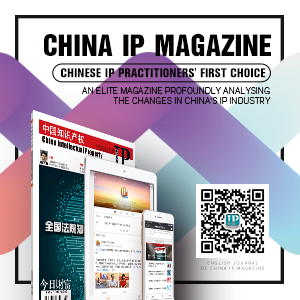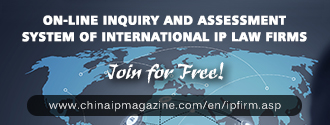The New Development of China Drug Patent Linkage System
Cheung Eva
Senior IP Executive of Simmons-Simmons (Beijing)
Intellectual Property Agency Company Limited
Naiquan Zhang
Intern of Simmons-Simmons (Beijing)
Intellectual Property Agency Company Limited
George Chan
Partner of Simmons-Simmons (Beijing) Intellectual
Property Agency Company Limited
Shoujie Meng
Associate of Simmons-Simmons (Beijing)
Intellectual Property Agency Company Limited
The drug patent linkage system stems from America’s Hatch- Waxman Act in America, formally known as the Drug Price Competition and Patent Term Restoration Act of 1984. It is a review procedure that investigates the relationship between a generic drug and the valid patent(s) covering a registered drug during the generic drug registration and approval process1. The system is introduced to streamline the generic drug administration approval process and to also address the issue of potential patent infringement during the generic drug approval process.
The main objective underlying patent linkage is to increase access to medicines by lowering drug prices, and at the same time balancing the interests of manufacturers of new drugs and generic drugs, to ensure healthy competition in the market.
The earliest Chinese regulations that offered a form of the drug patent linkage system emerged in 2002 with the “Administrative Measures for Drug Registration (Trial)”. The current version is the “Administrative Measures for Drug Registration (Order of the State Food and Drug Administration No.28)” (the “CFDA No. 28”), which was revised in 2007. Articles 182, 193 and 204 of the CFDA No. 28 set out a few provisions on issues such as the provision of a patent status statement, non-infringement statement, approval of a generic drug during the 2-year period prior to patent expiry, and data exclusivity period. However, after many years, gaps in the system became apparent and many concerns arose in relation to whether the regulations sufficiently protected the interests of innovator drug companies.
In practice, the applicant for the generic drug unilaterally provides the relevant drug patent status and non-infringement statement in the drug registration, however the China Drug Administration (“CDA”)5 is not required to verify the authenticity, veracity, or reliability of any noninfringement statement, nor is it charged to review any potential patent infringement issues. While the National Intellectual Property Administration (CNIPA) has no authority to participate in the drug approval process. Consequently, the CDA is very likely to approve a generic drug registration application without knowing whether the generic drug would infringe any patent right under the present regulations, and the generic drug applicant will not be liable for any, intentional or unintentional, errors in, omissions from, misstatements or misrepresentations found in their generic drug application.
The act of applying for the approval of a generic drug, per se, does not fall within the legal definition of patent infringement pursuant to Article 116 of the current Patent Law. And Article 69 of Patent Law, provides a “Bolar” exemption, which allows any party to manufacture, use, or import patented medicines or medical equipment; and allows any third party to have such patented medicines or medical equipment manufactured or imported specifically for the said party; both for the purpose of providing information necessary for administrative approval. In addition, Article 19 of the CFDA No.28 provides that, for a branded drug with patent rights obtained in China, any other applicant may apply for generic drug registration within two years prior to expiry of the patent.
The “Bolar” exemption is designed to encourage generic drugs manufacturers to conduct research and trials during the patent term of the new drugs, so as to accelerate the entry of generic drugs onto the market. It is controversial whether “submitting a generic drug application” is under the safe harbor of the “Bolar” exemption. However, in light of the above provisions, the fact that manufacturing, use, and importing activities for administrative approval are not acts of infringements, and that applications within two years of patent term expiration are legitimate, it seems that we cannot find a legal basis for the patent infringement liability of the generic drug application itself. As a result of the current legislation, there is no risk of patent infringement for generic drug manufacturers in the process of drug approval and pre-marketing activities. A patent infringement dispute could only be resolved after the generic drug entered the market.
Consequently, on the one hand, it is hard to protect the patent rights of a branded drug manufacturer because the patent infringement litigation related to medications and drugs is complicated and time consuming and the Courts tend to award a small amount of damages compared to the huge legal cost.
On the other hand, generic drug manufacturers will suffer enormous losses of prior investment if they obtain an injunction after marketing approval. Taken together, there is no sufficient safeguard either for the patent owner or the generic drug manufacturers, and the gaps of the current legislation will not only harm the interests of new drug companies, but also eventually inhibit the long term development of generic drug companies, resulting in a low level of drug R&D and manufacturing, and eventually frustrate innovation and deter the development of the indigenous pharmaceutical industry.
Over the years, particularly since 2016, the Chinese government has launched a series of policies and regulations aimed at stimulating medical innovation. The ultimate goal is to establish a practical patent linkage system in China, striking a balance between the competing interests of generic drug companies and branded drug companies, and strengthen branded drug’s development in China. This series of policies and laws can be summarized under the following headings: 1.Classification of Chemical Drugs and Abbreviated Generic Drug Applications On August 9, 2015, the “Opinions of the State Council on the Reform of Evaluation and Approval System for Drugs and Medical Devices” (the “Guo Fa [2015] No.44”) adjusted the definition of branded drugs from “drugs that have not been sold within the territory of China” to “drugs that have not been sold within or outside the territory of China”.
New drugs were further classified as innovative drugs and improved drugs. Furthermore, the definition of generic drugs is adjusted from “generic drugs for which the national standard has been established” to “genetic drugs with quality and efficacy consistent with the branded drugs”. The new drugs shall be used as reference preparations in evaluating and approving generic drugs to ensure that the genetic drugs are identical to a new drug with respect to bioequivalence. The definition of the generic drug here is the same as the US definition of Reference Listed Drug (“RLD”).
Based on the above principles, pursuant to the regulation of “the reform of the registration classification of chemical drugs (the “Classification”)” issued on March 4, 2016, drug registration classification was adjusted accordingly into five categories7:
I: Innovative new drugs not marketed anywhere in the world;
II : Improved new drugs not marketed anywhere in the world;
III: Generic drugs that are marketed in other countries, but not yet in China;
IV: Generic drugs that are already marketed in China;
V: Drugs that have been marketed overseas and are under an application for being listed in China.
In addition, Category I and II drug applications shall comply with the New Drug application process; Category III and IV drug applications shall comply with the Generic Drug application process; and Category V drug applications shall comply with the Imported Drug application process. Only the new Category I and II drugs are subjected to a monitoring period8 of three to five years, which is a de facto market exclusivity protection.
2.Establish a Catalogue of Marketed Drugs in China
According to Article XV9 of the “Opinions on Deepening the Reform of the Evaluation and Approval System and Inspiring Innovation of Drugs and Medical Devices” (the “Opinion”) issued on October 8, 2017, similar to the Orange Book from the U.S., the Chinese Government established a Catalogue of Marketed Drug (“Catalogue”) for China, A generic drug company should refer to the Catalogue for information in relation to a listed drug and can plan their marketing strategy accordingly. The Catalogue is expected to reduce the cost for manufacturing generic drugs. The Catalogue was launched and made available to the public on 28 December 2017 in a searchable database format at the following link: http://202.96.26.102/. According to the Users’ Guideline, the drugs below will be covered in the Catalogue:
A.approved innovative drugs, improved drugs and imported new drugs;
B.generic drugs registered under the new registration regime;
C.generic drugs which passed the evaluation of consistency in terms of quality and efficacy; and D.other drugs identified by the CDA.
The Appendix is the most important aspect of the Catalogue, which lists relevant patent and data protection information (i.e. data exclusivity and monitoring period exclusivity). At this stage, the Catalogue’s contents and the types of drugs covered remain very limited; however, it is expected that the CDA will gradually increase data from previously approved drugs, and update the directory from time to time10.
For generic drug companies, information on branded drugs and the relevant patents is an indispensable reference. As restated in the Article XVI of the “Opinion”, “in the application for drug registration, the applicant shall state the relevant patents and the patent ownership status, and notify the relevant drug patent holder of the relevant patents and the patent ownership status within a prescribed time limit”. Accordingly, generic drug applicants shall file certifications as to each patent listed in the Catalogue for a reference listed drug (RLD). However, until now, there is currently no further guidance as to what type of patents should be listed in the catalogue, and whether there is any party that is responsible for verifying the accuracy of the patent information, etc. If there is no limitation on the catalog of the patent right requested to record into the Catalogue, and no requirement to review the patent information the new drug companies will record their patent right to the extent possible, this leaves open the possibility that a new drug manufacturer could attempt to list as many patent rights with a listed drug to impede the marketing of the generic drugs. So far, the U.S. Orange Book clearly defines which patents are to be recorded in the Orange Book and which are not11. Moreover, to avoid the abuse of “30-month stay”, the Medicare Prescription Drug, Improvement, and Modernization Act of 2003 (the “2003MMA”) forbade multiple “30-month stay” applications by adding additional related patent in the Orange Book, and provides that the starting date of the 30-month period in which a first applicant must obtain tentative or final approval or risk forfeiture is one day after the date that a first applicant submits its substantially complete application12. Thus, only one “30-month stay” is allowed for each abbreviated new drug application (“ANDA”)13.










